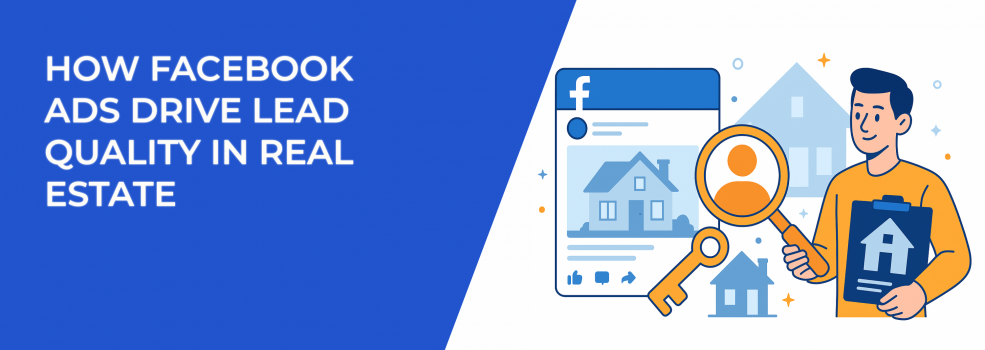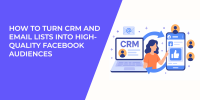Facebook Ads have become essential for real estate marketers aiming to generate high-quality leads. But while many campaigns focus on volume, the more important goal often gets overlooked — lead quality.
In real estate, low-intent leads clog your pipeline. They inflate your metrics but rarely result in showings or closings. The question real estate advertisers should ask isn’t “How do I get more leads?” but rather, “How do I attract people who are ready to act?”
Let’s explore how to use Facebook Ads not just to reach people, but to attract serious home buyers, sellers, and investors — the kind of leads that actually convert.
Why Facebook Ads Still Work for Real Estate
Despite targeting limitations and evolving privacy rules, Facebook remains one of the best digital platforms for real estate lead generation.
Why? Because people don’t start their home search on Google — they start it subconsciously. They scroll past a beautifully staged home, imagine themselves living there, and then begin to engage.
Facebook and Instagram allow advertisers to:
-
Reach users early in the decision-making cycle,
-
Showcase listings visually in a way search ads can’t,
-
Retarget users who interact with listings but don’t convert right away.
Real estate is emotional. These platforms let you tap into that emotion before logic and competition takes over.
How to Target for High-Quality Real Estate Leads
Facebook targeting has changed, but lead quality has improved for advertisers who know how to adapt. The key is shifting away from shallow interest targeting and toward behavior- and intent-based strategies.
Here’s what works:
1. Custom and Lookalike Audiences
Start by uploading your own data to Facebook. Use:
-
CRM contacts;
-
Past buyers or sellers;
-
Website visitors;
-
Newsletter subscribers.
Then build lookalike audiences based on your best leads — not just anyone who filled out a form. This helps Facebook find people with similar behavior.
You can also use LeadEnforce to target users who engage with specific Facebook groups or Instagram pages, like local real estate brands or competitors. This gives you warm custom audiences, even if you don’t have a big email list or website traffic yet.
Learn how to use both effectively in Custom vs Lookalike Audiences: What Works Best for Facebook Campaigns.
2. Hyper-Local Targeting
Don’t target an entire city if you don’t need to. Instead:
-
Focus on specific zip codes or neighborhoods;
-
Mention local schools, parks, or landmarks in your ad copy;
-
Run separate ads for buyers and sellers.
Local targeting improves relevance — and helps you reach people who actually want homes in your area.
For more tactics, see Hyper-Local Facebook Ad Targeting: Zip Code Strategies That Convert.
3. Retargeting People Who Engaged
Show ads to people who already showed interest. Retarget users who:
-
Watched your videos;
-
Clicked on your ads;
-
Viewed multiple pages on your site;
-
Liked or saved your Instagram posts.
These people are warmer and more likely to convert. You can set this up in Facebook’s Engagement Custom Audiences — or use LeadEnforce to go even deeper.
Ad Creatives That Attract the Right Prospects
Getting the right leads isn’t just about targeting. What your ad says — and shows — plays a big role in who clicks.
Your creative helps qualify leads before they fill out a form. Strong ads attract serious buyers and filter out people who aren’t a good fit.
Here’s how to improve your real estate ad creative:
1. Include Price and Location
Be specific in your headline or main text. For example: “3BR in North Ridgeville — Under $450K.”
This kind of detail tells people right away if the home fits their budget and area. It also helps avoid clicks from users who are just browsing.
2. Use Real Photos or Virtual Staging
Show real listing photos or high-quality virtual staging. Avoid stock images — they don’t build trust.
People want to see the actual home (or something close to it). Real visuals perform better and help your ad stand out in the feed.
3. Highlight What’s Unique or Time-Sensitive
Create urgency or interest with short, clear copy. Try something like: “Newly renovated. Open house this weekend.”
Simple details like this make the ad more clickable and help serious buyers take action faster.
For creative ideas that convert, check out Crafting Compelling Facebook Ads Copy That Converts.
4. Use the Right Call-to-Action (CTA)
Match your CTA to where the buyer is in their journey:
-
“See Photos” works well for early interest;
-
“Schedule a Tour” is better for motivated leads.
Choose your CTA carefully — it sets the tone for what happens next.
Optimize Landing Pages to Hold Interest
You’ve paid for the click — now you need to hold attention.
Many real estate campaigns lose leads after the click. A slow, cluttered, or off-topic landing page drives even serious buyers away. Think of your landing page like a virtual showing — it needs to be smooth, clear, and focused.
Here are best practices for high-converting real estate landing pages:
-
Keep load times under 3 seconds. Most users won’t wait. Compress images, avoid heavy animations, and make sure your mobile version loads fast.
-
Display the exact property featured in the ad. Don’t link to a homepage or a general listings feed. If your ad promotes a specific home, show only that home on the landing page — with price, photos, and key details.
-
Use large, clear images and easy-to-read text. Let the visuals speak. Clean, high-resolution photos work best. Keep headlines short and copy scannable, especially for mobile users.
-
Minimize form fields. Ask for just what you need — usually name, contact info, and buying timeline. Fewer fields lead to more completions and better user experience.
-
Include trust signals. Add elements that make users feel safe and confident:
-
Client reviews or testimonials;
-
Brokerage logo and license number;
-
“As seen in” badges or awards.
-
Bonus tip: create separate landing pages for buyers and sellers. That way, your message speaks directly to their needs — and improves both conversion rate and lead quality.
Your landing page should feel like the next logical step after the ad — not a detour. Keep it relevant, fast, and easy to act on.
Lead Quality Signals: What to Track
Click-through rates and cost per lead only tell part of the story. To know if your Facebook Ads are attracting the right leads, you need to track what happens after the form is submitted.
Here are the most important metrics to focus on:
-
Response rate: Are leads replying to your emails or messages? If most go silent, revisit your ad copy or audience targeting.
-
Appointment rate: How many leads are booking tours or calls? This is a strong sign of genuine interest.
-
Lead quality score: Ask your sales team to rate leads based on how ready they seem. High-quality leads are engaged, responsive, and serious.
Tracking these signals helps you spot what’s working and where to adjust. If a certain ad consistently brings in silent or unqualified leads, pause it. If another leads to booked showings, double down. Real optimization happens after the click.
If you’re stuck analyzing only top-of-funnel data, read How to Analyze Facebook Ad Performance Beyond CTR and CPC for deeper insights.
Final Thoughts
Facebook Ads remain one of the most effective ways to drive real estate leads in 2025 — if your strategy emphasizes quality over volume.
With the right combination of targeting, creative, landing page experience, and lead tracking, you can build a system that attracts buyers and sellers who are motivated, informed, and ready to act.
Don’t just aim for more clicks. Focus on better ones.
Because in real estate, a single qualified lead can be worth more than a hundred random names in your database.

